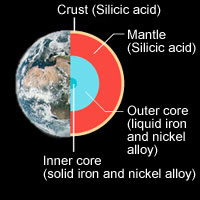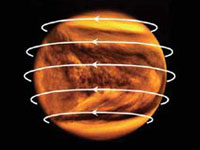Basic Information on Venus

- Average distance from the Sun: 108.2 million kilometers
- Size (equatorial radius): 6,052 kilometers
- Mass (compared to that of the Earth): 0.815 times
- Average density: 5.24 g/cm³
- Revolution period: 224.7 days
- Rotation period: 243.02 says
Image: Venus taken by Magellan Venus Explorer © NASA/JPL


Venus: the most similar planet to the Earth
Venus circulates just inside the earth's revolution orbit, thus it comes closest to the earth. Its diameter is 0.95 times that of the Earth, and its weight is 0.82 times. Therefore, both its size and weight are also very similar to that of the Earth. The inside structure is also believed to be very close to that of the Earth. Venus's crust from its surface to around 30 km consists of silicic acid. Beneath that crust, a mantle also comprised of silicic acid spreads out. At the center, there is a core made of iron and nickel.Venus covered by thick clouds
 Venus has a very thick atmosphere which mostly consists of carbon dioxide (CO2.) Due to this atmosphere, a very strong greenhouse effect occurs, and the temperature on the surface of Venus is 460 degrees Celsius both during the day and night. This temperature is much higher than that of Mercury, which is closer to the Sun. In the atmosphere, clouds made of sulfuric acid particles spread out, and these clouds block sunlight from directly reaching Venus' surface. These clouds also cause sulfuric acid rain, but it evaporates before it arrives on the surface because of the extremely high temperature. On the upper layer of the Venus atmosphere, strong winds of 100 m/s, which take only one hour to circulate around Venus, blow. This wind is called a "Super Rotation." It is not known why such a strong wind blows as the rotation period of Venus is very slow.
Venus has a very thick atmosphere which mostly consists of carbon dioxide (CO2.) Due to this atmosphere, a very strong greenhouse effect occurs, and the temperature on the surface of Venus is 460 degrees Celsius both during the day and night. This temperature is much higher than that of Mercury, which is closer to the Sun. In the atmosphere, clouds made of sulfuric acid particles spread out, and these clouds block sunlight from directly reaching Venus' surface. These clouds also cause sulfuric acid rain, but it evaporates before it arrives on the surface because of the extremely high temperature. On the upper layer of the Venus atmosphere, strong winds of 100 m/s, which take only one hour to circulate around Venus, blow. This wind is called a "Super Rotation." It is not known why such a strong wind blows as the rotation period of Venus is very slow. Mystery of Rotation Direction
The Venus revolution period of about 225 days is shorter than its rotation period of 243 days. In addition, the rotation direction is opposite to that of the other seven planets. Therefore, the sun rises from the west and sets to the east (but you probably could not see the sunrise or sunset from Venus because of the thick clouds.) It is still one of the major mysteries of the universe why the rotation of Venus is in the opposite direction.Waxing and waning Venus
We can see Venus near the sun from the Earth, thus it is found either in the evening sky or morning sky. We never see it during the night. When it is at its brightest, its magnitude is minus 4, and it is often called the "evening star" or "morning star." Venus is also waxing and waning. As it circulates just inside of the Earth's revolution orbit, its distance from the Earth is drastically different when it is closest to the Earth and when it is at its farthest point. Therefore, you can enjoy the different sizes and shapes of Venus by observing it at different times.Foreign Venus exploration projects
The first Venus exploration mission was in 1961, about 50 years ago, when the Venera 1 was launched by the former Soviet Union. The next year, the United States followed suit and launched Mariner 2, then the two countries competed against each other in space development during the cold war era. Missions included the Pioneer Venus (1978 to 1992, U.S.), Vega 1 and 2 (1984, Soviet Union), and Magellan (1989, U.S.)In recent yeas, the Venus Express launched by the European Space Agency in November 2005 was injected into the Venus orbit (polar orbit) in April 2006. The Venus Express is still on orbit observing mainly Venus's atmospheric composition and studying the plasma environment spreading around Venus by using remote sensing technology.
